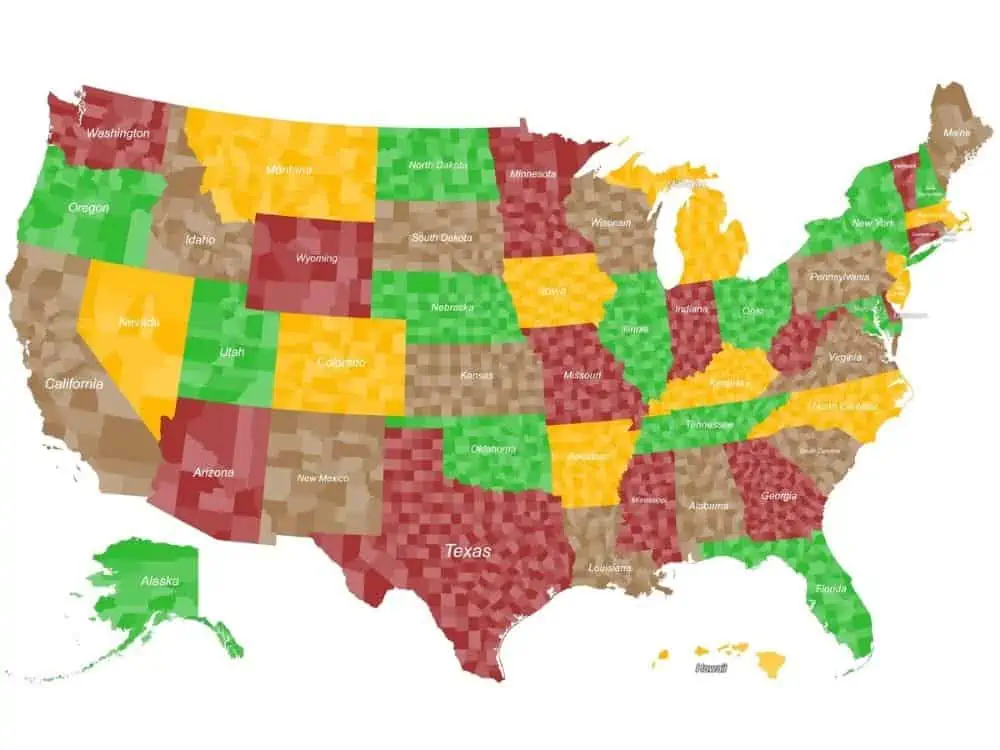Share the post "Lone Star Loyalty: History + Meaning Of Texas Pledge"
Texas is famous for many things as the second-largest state in the nation. Though most people know the Lone Star State, few realize it has a pledge.
Why does Texas have a pledge, and what’s its story? Read on to learn more.

Why Does Texas Have a Pledge?
Before becoming one of the country’s states, Texas underwent several transformations. It began as a colonial region under European nations and later gained independence as part of a sovereign country. The pledge was a way to celebrate this independence.
Historical Background:
- The pledge was originally written in 1933 by the Daughters of the American Revolution.
- It has changed over time, most notably by adding the words “under God” in 2007, aligning it more closely with the U.S. Pledge of Allegiance.
The Texas Pledge is integral to the state’s identity, reflecting its distinct cultural and historical significance within the United States.
Reasons for The Texas Pledge
- Unique History: Texas has a rich and unique history, having been an independent nation, the Republic of Texas, from 1836 to 1845 before joining the United States. This period of independence is a source of pride for many Texans and contributes to a strong sense of state identity.
- Cultural Identity: The state’s distinct cultural heritage, influenced by its Spanish and Mexican past, as well as its Native American and immigrant cultures, has fostered a strong sense of identity among its residents. The Texas Pledge helps reinforce and express this identity.
- State Pride: Texans are known for their state pride. The pledge serves as an expression of this pride and a reminder of the state’s unique characteristics and values.
- Educational Purpose: The Texas Pledge helps instill a sense of state history and civics in schools. It is a part of educational efforts to promote knowledge about Texas’s history, government, and cultural significance.
- Symbol of Unity: The pledge serves as a unifying element among the diverse population of Texas. It emphasizes unity and allegiance to the state, reinforcing the idea of being “Texan” regardless of individual background.
- Political and Social Statement: Over time, the pledge has also become a way for Texans to make a political or social statement, reflecting their views on state sovereignty, the role of religion in public life (as seen in the inclusion of “under God”), and other matters of public interest.
- Legislative Action: The formal adoption and modifications of the pledge, such as the addition of “under God” in 2007, reflect legislative actions that align with public sentiment and political priorities at various times.
The existence of the Texas Pledge is a testament to the state’s unique position within the United States, representing a blend of historical significance, cultural identity, and state pride.

Texas Flag History
The iconic single-star design of the Texas flag today wasn’t always symbolic of the state. Texas has gone through six flags since the colonial days, and today’s flag wasn’t implemented until 1839.
The slogan “Six Flags Over Texas” portrays the history of Texas through the ages. During the colonial era, Texas was governed by Spain, France, and later Mexico.
Mexico became independent from Spain in 1821. At the time, its territory included the state of Texas, which Spain had previously controlled. Several elements of the Spanish constitution remained in place. The next century would be a turbulent period, as the region was among the poorest in the Mexican Federation.
In 1832, led by David Burnet, Texans formed a convention hoping to implement several new resolutions. However, the Mexican government rejected these. That led to tensions worsening and eventually to a revolution.

What is The Texas Pledge
“Honor the Texas flag; I pledge allegiance to thee, Texas, one state under God, one and indivisible.”
Key Elements of the Texas Pledge:
- Honor the Texas Flag: This opening line emphasizes respect and reverence for the Texas flag as a state symbol.
- Allegiance to Texas: The pledge expresses a commitment to the state of Texas, akin to the pledge of allegiance to the United States.
- One State Under God: This phrase, added in 2007, acknowledges a religious element similar to the phrase “under God” in the United States Pledge of Allegiance. Its inclusion has been a subject of debate and controversy.
- One and Indivisible: This part of the pledge emphasizes the unity and indivisibility of Texas as a state.
Context and Usage:
- In Schools: Texas law requires the state pledge to be recited in public schools, usually after reciting the U.S. Pledge of Allegiance.
- Public Events: The Texas Pledge is also often recited at state government meetings, official functions, and various public gatherings in Texas.
Changes in The Pledge Over The Years
The Texas Pledge of Allegiance has undergone several changes since its introduction, reflecting the state’s evolving cultural and political landscape. Here’s a brief overview of its history and modifications:
- Original Introduction (1933): The Texas Pledge was first introduced in 1933 by the Texas Legislature. The original wording was simple: “Honor the Texas flag; I pledge allegiance to thee, Texas, one and indivisible.”
- First Major Change (1965): In 1965, the pledge underwent its first significant modification. The words “one and indivisible” were replaced with “one state under God, one and indivisible.” This change was influenced by the national mood at the time, which was moving towards including religious phrases in pledges and mottos, as seen in the addition of “under God” to the United States Pledge of Allegiance in 1954.
- Most Recent Change (2007): The most recent change came in 2007 when the Texas Legislature passed a bill to include the phrase “one state under God” officially. The revised pledge reads: “Honor the Texas flag; I pledge allegiance to thee, Texas, one state under God, one and indivisible.”
These changes reflect the dynamic nature of Texas’s cultural and political identity. In both instances, the addition of “under God” mirrored broader national trends and sentiments regarding religion’s role in public life. Each modification to the Texas Pledge has been discussed and debated, highlighting the ongoing evolution of state identity and values in Texas.
The Texas Revolution began in 1835. Outraged at the centralist Mexican government, U.S. colonists teamed up with Hispanic Texans Tejanos to rebel. After a year of battle, Texas declared independence from Mexico on March 2, 1936.
Texans signed their Declaration of Independence at Washington-on-the-Brazos. Today, many refer to the location as the Texas birthplace.
David Burnet became a provisional president of Texas after the state declared its independence. According to some accounts, Burnet designed the Texan flag at the time. Thus, the blue flag design with a single yellow star still goes by the Burnet Flag.

Origins of the Texas Flag Pledge
Though two other flag designs came after the Burnet flag, the Texas legislature assigned a pledge to the flag in the early 1930s. Thus, the pledge referred to the Burnet flag of 1936 rather than the subsequent lone star design.
The original pledge read: “Honor the Texas Flag of 1836. I pledge allegiance to thee, Texas, one and indivisible.”
In 1951, Senator Searcy Bracewell drafted a bill to change the wording of the flag pledge. However, the legislature did not correct the reference in the pledge until 1965. Though the Texas pledge today refers to the modern Lone Star flag, the flag’s designer remains unknown.
The purpose of the state flag pledge was to show respect for Texas’ rich history. Texas was once a sovereign nation, and this is what the flag pledge aims to commemorate. In honor of that history, Texas flies its state and American flags.

Controversy Surrounding The Texas Pledge in Schools
The controversy surrounding reciting the Texas Pledge of Allegiance in schools reflects broader debates over patriotism, individual rights, and educational practices.
Background:
- The Texas Pledge: “Honor the Texas flag; I pledge allegiance to thee, Texas, one state under God, one and indivisible.”
- Legislation: Texas law requires the state pledge to be recited in public schools, typically following the U.S. Pledge of Allegiance.
Points of Controversy:
- First Amendment Concerns:
- Freedom of Speech: Critics argue that mandatory recitation may infringe on students’ free speech rights. The right not to speak or participate in a pledge is protected under the First Amendment.
- Religious Language: The phrase “under God” has been a point of contention, with some arguing it blurs the line between church and state.
- Educational Focus:
- Patriotic Education vs. Critical Thinking: There’s a debate over whether the emphasis on patriotic rituals detracts from fostering critical thinking and a more comprehensive understanding of history and governance.
- Cultural and Historical Sensitivity:
- Diverse Perspectives: Texas’s diverse population means varied state and national identity views. Some argue the pledge does not reflect the experiences or beliefs of all Texans.
- Historical Context: The pledge’s history and the symbolism of the Texas flag can be controversial, particularly in the context of Texas’ past, including its history of secession and racial segregation.
Educational Implications:
- Opt-Out Provision: Texas law allows students to opt out of reciting the pledge with parental permission, which is intended to accommodate differing views but has been a debate.
- Role of Educators: Teachers and administrators often navigate the challenge of upholding state requirements while respecting individual student rights.
Societal Reflection:
- The debate mirrors more extensive national discussions about patriotism, state loyalty, and the role of education in shaping civic identity.
The controversy is about reciting the pledge itself and broader issues of civic engagement, individual rights, and how history and patriotism are taught in schools. It reflects the ongoing dialogue about identity, values, and education in a diverse society like Texas.

State Pledges and Requirements
Texas is not the only state with a flag pledge. The following states also have a pledge to the state flag:
- Alabama
- Arkansas
- Georgia
- Kentucky
- Louisiana
- Michigan
- New Mexico
- North Carolina
- Ohio
- Oklahoma
- Rhode Island
- South Carolina
- South Dakota
- Tennessee
Though Texas is far from the only state with a flag pledge, it is the only one where citizens recite it in schools. However, not all Texas schools have students recite the state pledge. Many Texans have never done so.
Notwithstanding, under section 25.082, the Texas Education Law states that students should recite the state pledge in addition to the pledge of the United States. Texas schools allow families to have their children opt out of reciting the pledge to the Texan flag.
Opposition To Recital Requirements
In 1943, the Supreme Court ruled that it was unconstitutional for any state to require the recital of its flag pledge. Despite this, Texas has introduced several laws to require the recital in schools but allow students to opt-out.
Thus, though it isn’t compulsory, many Texan schools still recite the flag pledge and the pledge of allegiance to the country.

Rules of the Texas Pledge of Allegiance
The Texas pledge of allegiance must come after the pledge of allegiance to the United States. The rules state that a person should remove head coverings before the recital.
The following steps are to face the flag, stand straight, and place the right hand over the heart, touching the left shoulder. When in uniform, a person must utilize a military salute. The recital is then followed by a moment of silence. Aside from schools, recitals of the Texas pledge may take place at any historical event or celebration.
The Texas Pledge of Allegiance, like the United States Pledge of Allegiance, is recited in various settings, particularly in schools and state government-related events. Here are the key rules and protocols typically associated with its recitation:
- Wording of the Pledge: The current wording of the Texas Pledge of Allegiance is: “Honor the Texas flag; I pledge allegiance to thee, Texas, one state under God, one and indivisible.”
- Standing and Facing the Flag: Participants are expected to stand and face the Texas flag during the pledge recitation. This is a sign of respect and patriotism.
- Hand over Heart: Similar to the United States Pledge, individuals reciting the Texas Pledge typically place their right hand over their heart. This gesture symbolizes loyalty and respect for the state.
- Recitation in Schools: In Texas public schools, the state law mandates that students recite the Texas Pledge of Allegiance daily, following the United States Pledge. However, students may be excused from participating in the pledge on written request from a parent or guardian.
- Legislative Sessions: The Texas Pledge is often recited at the beginning of legislative sessions in the Texas State Capitol.
- Public Meetings and Events: The pledge may also be included in the opening ceremonies of various public meetings and events throughout the state, particularly those with a governmental or civic focus.
- Special Occasions: The Texas Pledge might be featured more prominently during state holidays, such as Texas Independence Day, or at historical commemorations.
These rules and practices around the Texas Pledge of Allegiance aim to foster a sense of state pride and unity while also respecting individual rights and freedoms. The pledge is integral to Texas’s cultural and civic rituals, reinforcing the state’s unique identity within the United States.

Texas Pledge FAQs
Below are the answers to the most frequently asked questions about the Texas state pledge.
What are the words to the Texas Pledge of Allegiance?
The Texan Pledge of Allegiance is as follows:
“Honor The Texas flag. I pledge allegiance to thee, Texas, one state under God, one and indivisible.”
What is the proper hand position for the Texas pledge?
The hand position for the Texas pledge is the same as that for the country pledge. The right-hand goes over the heart and touches the left shoulder.
Is Texas the only state with a flag and pledge of allegiance?
Seventeen states have an allegiance to the state flag. However, Texas is the only one to pass several laws to keep the recital requirements in schools. Today, many Texan schools require students to recite the pledge but are given the option not to with a parent’s signature.
Though not every state has a pledge to its flag, all states have a flag.
Can the Texas flag fly higher than the US flag?
The Texas state flag does not fly higher than the US flag, and there is no federal law that allows it. However, before joining the union, both flags flew at the same height out of respect for Texas’ history as a sovereign nation.
Share the post "Lone Star Loyalty: History + Meaning Of Texas Pledge"
Christian Linden is a seasoned writer and contributor at Texas View, specializing in topics that resonate with the Texan community. With over a decade of experience in journalism, Christian brings a wealth of knowledge in local politics, culture, and lifestyle. He holds a Bachelor's degree in Communications from the University of Texas. When he's not writing, Christian enjoys spending weekends traveling across Texas with his family, exploring everything from bustling cities to serene landscapes.











